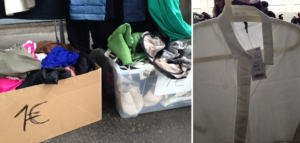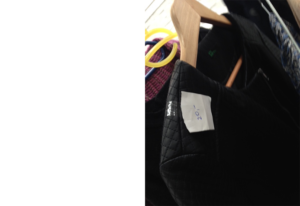thoughts

Moving Wardrobes Project: Ethnographic Vignette I
- April 25, 2016
- ethnography
Gaining access to the field is generally not an easy task, but it seems much harder if one relies on contacting strangers through online discussion boards and when the proposed project implies not answering predefined questionnaires through online surveys but visiting participants in their own homes.
In this initial phase full of disappointing dead-end approaches, it feels nice to at least start somewhere and move in some direction. For this very reason I decided to visit two local flea markets during the weekend and talk to some of the people selling their clothes. Even tough I’m interested specifically in clothes sold online, I thought this would maybe give a good first impression for learning more generally about second-hand clothes. Little did I think about the fact that looking at flea markets and talking to people who did both (selling used clothing on flea markets and online) would point to the ways in which flea markets are radically different to online second-hand marketplaces. Another positive side effect of my trip to these markets is getting to know people and inviting them in person to participate. People seem way less reluctant and quickly find themselves showing and talking about individual items of clothes. I will definitely repeat these visits as they prove to be a good (material) experience and immersion into the world of second-hand clothes. For now, these are my impressions of my first two visits.
Strolling through the flea markets, I approached those stalls which sold predominantly clothes. I did not, however, talk to those who were professional sellers and had permanent stalls at the markets. Professional dealers were easily distinguishable from private sellers, in that their clothes were arranged in a more organized way, both in the way they were presented but also in that they seemed to follow a specific style (such as a ‘vintage’ style). Also, and this is probably the most important observation, the private sellers’ clothes are practically the same sort of mass-produced, ‘in-trend’ garments that are being sold at high street shops. Consequently, and as emphasized by all the sellers I’ve talked to, people who were shopping at their stalls were essentially looking for a good bargain since they could not so much hope to find one of a kind or rare pieces.
As I had expected, the sellers were mostly women and stalls were shared with female friends or relatives (some had also brought their husbands or boyfriends and some of their stuff along). I could spot two types of age groups, one was in their 20s, and the other type of sellers were in their 50s or 60s. As the former group is more relevant to my specific interest, online marketplaces, I did mostly talk to them.
It became apparent, after talking to about 20 sellers (mostly women and in their 20s), that there was a striking pattern when it came to motivations and rationales to sell, and the type of clothes being sold. First of all, the sold items were much newer than I had expected, most of the garments being 1 to 6 years old. Some of the clothes were as new as 6 months and almost every stall was able to show me one or three items that still had price tags on them. When it came to reasons for discarding garments, the most stated one was ‘I’m just not wearing it anymore’, with reasons like wrong fit or size or disliking the item ranging way below in the level of significance. Some even admitted that they still liked some garments and that nothing was wrong with them but that they had since acquired more clothes and were ‘just not wearing more than ten tops at a time’. Some sellers had self-imposed rules that forced them to discard any item that had not been worn in a considerable time frame (for some, this meant 6, for others 12 months), or to discard one old item for each new acquisition they made.

On the left: boxes with ‘1€’ written on them / on the right: items with price tags still on them could be found at almost every stall
The most insightful part of my visits was probably taking to the sellers about selling their clothes on the flea market versus online. As it turned out, most of them had accounts on Kleiderkreisel.de, the marketplace I am most interested in. The types of clothes they sold and the way they framed these sites respectively differed in very important ways. For one, most sellers were regulars at flea markets and stated that they tended to do flea market sales once a year to organize their wardrobes and get rid of stuff to make more space (often for new stuff). Bringing their stuff to flea markets was thus one way of getting rid of it. And that was the central rationale guiding their sale practices. Low prices were emphasized with 1€ signs ranging over boxes full of small items of clothes. Sellers did not insist that much on specific prices, and things that they were not able to sell at the end of the day made their ways to charities. Making money, it seemed, was a nice side effect but there was almost no expectation of how much one wanted from one’s stuff. When it came to monetary value, most sellers did not see any left in their clothes. As one seller put it:
“You just cannot expect people to pay more than one or three euros for something, especially if the label says H&M or so. You see, H&M has regular sales with huge discounts. That means you can get a top, completely new and right from H&M for sometimes as little as 2€. People just don’t understand why they should pay more here, where things have even been worn.”
Consequently, for most sellers, the only way they were able to extract monetary value from their pre-worn stuff was through offering quantity. You go and sell each item for not more than 6 Euros, but you sell lots of it. It became evident that selling clothes online was very different to this.
Online, sellers said, everything was much more complicated. You had to upload pictures, write description, put clothes in packages and send them off. Additionally, you had to “deal with customers” that asked for measurements, had further questions concerning the condition of the item, wanted pictures of the item being worn and so on. However, for some types of garments the effort did pay off in that they could sell them for much more than on a flea market. Online, buyers “recognize the value of the clothes”. Importantly, this only applied to certain types of clothes. Mostly, these were branded clothes or clothes from very specific and popular stores or items of distinguished quality (such as real leather). Online, you could tag the clothes with their brand names or put hashtags on them to highlight the value.
It was interesting to see that these items had often not even been brought to the flea market sale, as they were perceived as being just too valuable. When brought along, they were hung or presented in a prominent way on the racks or the walls, marking their value. They were never put into boxes or thrown onto the folding table. In one particularly interesting case, the seller had attached a self-written price tag on a leather jacket (while no other item had such a tag) to emphasize the fact that the price was most definitely not negotiable, or that the range for negotiation was very narrow.

The seller had attached a 20€ price tag to the jacket, as she found it to be more valuable than her other items.
What is valuable to people, and what is not, becomes apparent in the way things are arranged and, it turns out, for most sellers, the most valuable things do not belong on a flea market.
But the most interesting thing that has arisen from my observations and interviews so far, is that no matter how different the women and their clothes were, everyone emphasized the importance of clearing their wardrobes. Above financial gains, sustainable practices or very practical reasons, having an organized and selected wardrobe of clothes seems to be the most important reason for selling stuff. It seems that this insistence and motive points to something very important in the field.